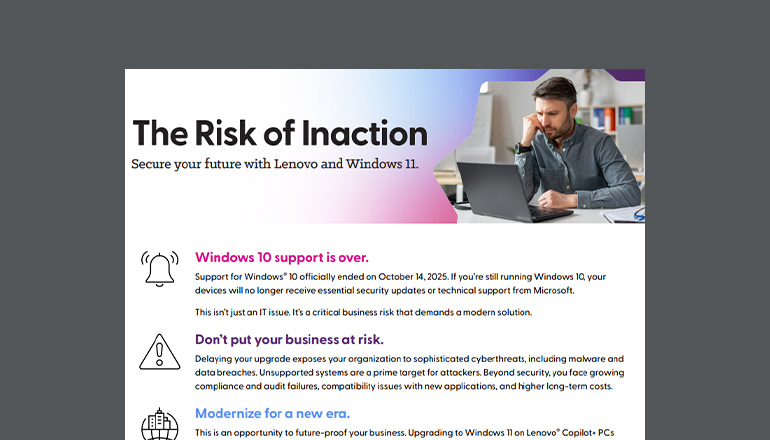Client story Health Management Company Streamlines Call Centers
For one health management company, coordinating with hospitals, employers, government agencies and health plan providers was a major part of daily business. When it became apparent that the organization’s mis-matched call center solutions were negatively affecting both the customer and employee experience, business leaders decided it was time to make a change.
By Insight Editor / 4 Jun 2020 / Topics: Modern workplace Unified communications

Facts at a glance
Client industry:
Health management
Size of company:
2,500+ employees
Challenge:
The company was using multiple contact center solutions across its call centers. Some contact center groups were on an older software platform, while others were on another, pre-packaged solution. The company needed one solution to unify its call centers and minimize daily admin tasks.
Solution:
Insight proposed an upgrade process that would use the client’s current hardware in conjunction with Cisco’s Packaged Contact Center Enterprise (PCCE), an on-premise contact center solution.
Results:
- Migrated all call centers to the PCCE solution
- Developed an upgrade process to utilize client’s current hardware
- Re-architected existing call routing scripts and deployed courtesy callback
- Deployed a call-flow administration process to delegate admin tasks to business owners at each location
Solution area:
Insight’s Connected Workforce solutions are a suite of end-user compute offerings designed to simplify IT management while improving connectivity and collaboration.
Inconsistencies everywhere
While the company had tried to improve its call center experience in the past, the results of that improvement were disappointing to say the least. In the end, the company was left with disparate solutions across its 25+ locations. Many of its contact center groups were still operating from an older software solution, while others had been upgraded to a new, but not ideal contact center solution.
The lack of unity between call centers was difficult to manage and also provided an inconsistent customer experience between locations. Business leaders were tired of dealing with different systems — they wanted a single solution for all locations. They also wanted each location to be able to manage its own daily administrative tasks within the solution.
For this contact center overhaul, the company decided to call on Insight to execute a full cut-over to Cisco® Packaged Contact Center Enterprise (PCCE).
Sizing up the challenge
Given the client’s current state, delivering the functionality they wanted within the timeframe they wanted wouldn’t be easy.
We knew we had to migrate all their call centers into the Cisco PCCE solution. We also knew the client wanted to leverage the hardware they already had. However, much of the hardware they’d purchased was not configured to run with the new contact center solution. That meant we needed to convert the hardware for use in the contact center.
In addition to simply enabling the new system, the client also wanted help streamlining the call-routing process and implementing virtual hold functionality. On top of that, the client needed a way to delegate daily admin tasks to individual administrators at each location. Finally, there was a tight deadline to consider. From the start, we knew the project would be a challenge.
Best laid plans
We began by developing a process to upgrade the client’s call centers using the hardware they already had. We provided the guidelines and assisted in converting the hardware for the Cisco contact center. We then designed an approach to migrate all of their call centers to the PCCE solution.
The timeline was already tight, but then the client encountered an issue with Cisco orders that had been placed outside the proper approval and assessment process. We assisted with troubleshooting issues that were beyond the original scope of work. Some issues were completely unique to the client’s environment — not even Cisco had encountered them before.
To account for these under-scoped hours and ensuing delays, the scope of the project had to be reduced to fit the budget. Insight Architect, Aaron Travis, recounted the engagement, saying, “We worked a lot of extra hours, but managed to complete the project within an acceptable tolerance for both adjusted budget and customer timeline.”
Streamlined call-routing and task administration
With their original system, the client had a large number of in-bound call routing scripts. In order to streamline the call-routing process for the new system, we needed to consolidate wherever possible.
To simplify, we re-architected all existing scripts and deployed Courtesy Callback as well. This consolidation not only reduced our timeline, but also created a more uniform experience across call centers and gave the client less scripts to maintain going forward.
To give the client the ability to delegate administrative tasks, we deployed our custom Call-Flow Administration (CFA) program. Insight’s CFA program allows the client to hand off control of certain aspects of the contact center system to individual team leads or supervisors without granting them access to tools that could cripple the contact center.
With these tactics, our team managed to consolidate all the disparate call centers under a single, unified software solution. Individual office locations can now control their own internal processes, taking a significant portion of the day-to-day administration off the support and infrastructure teams.
The client is now running an up-to-date software solution on hardware they already owned and are prepared with a solid plan for migrating to new hardware when the time comes. In summing up the engagement, Architect Aaron Travis had this to say: “We seem to have excellent working relationships with their technical and management resources. Enough that we’ve been asked to return twice.”



